#house of saxe coburg saalfeld
Text

On July 11th, 1818, a double wedding was held at Kew Palace. The grooms were the future William IV, and his younger brother Prince Edward, the Duke of Kent. They were marrying Princess Adelaide of Saxe-Meiningen and Princess Victoria of Saxe-Coburg-Saalfeld respectively, and the brides were given away by the elder brother of the grooms, the Prince Regent.
The reason for the double wedding? George III’s only legitimate grandchild, Princess Charlotte Augusta, had died in childbirth the previous year along with her son. With his two eldest sons long estranged from their wives, this led to the next two sons abandoning their mistresses and illegitimate children in an effort to father a legitimate heir to the throne.
Although Adelaide and William had the first child, she and the four siblings who came after her did not survive long, or were stillborn. It was ultimately the Duke and Duchess of Kent who would give birth to the future monarch, Queen Victoria.
#william iv#george iv#prince edward#Adelaide of Saxe-Meiningen#Victoria of Saxe-Coburg-Saalfeld#queen charlotte#regency era#house of hanover#british royal family
29 notes
·
View notes
Text
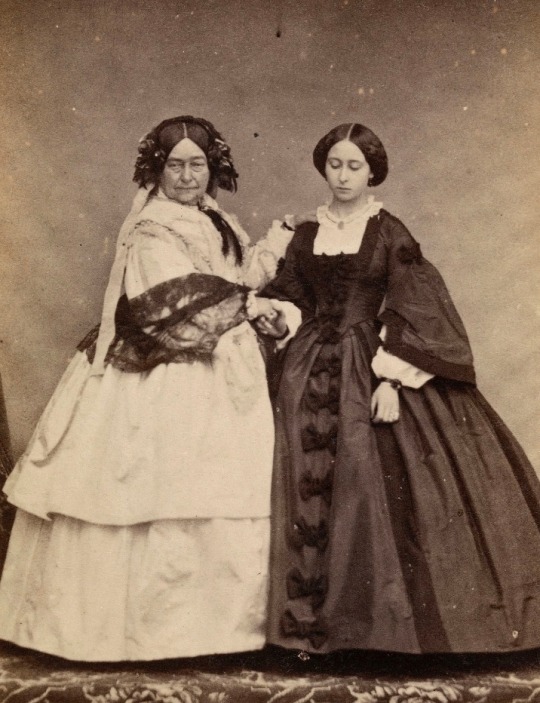

Princess Alice of the United Kingdom and her grandmother Victoria, Duchess of Kent, 1860.
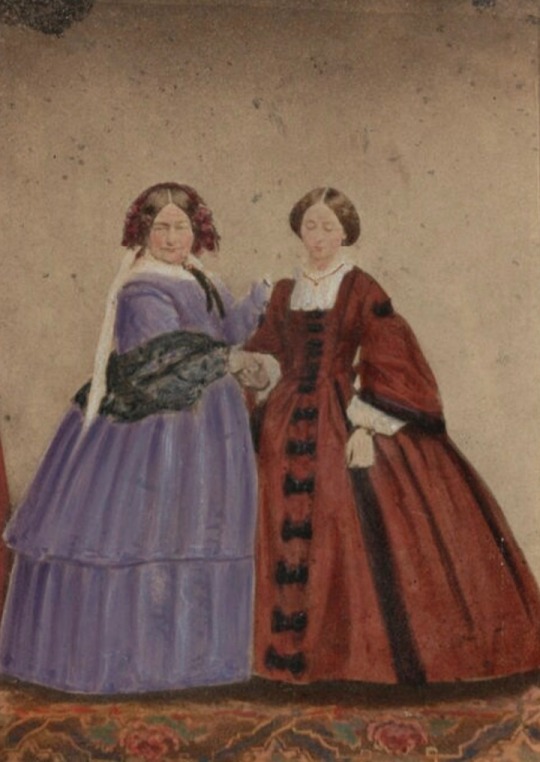

—
Princess Alice VA CI (Alice Maud Mary; 25 April 1843 – 14 December 1878) was Grand Duchess of Hesse and by Rhine from 13 June 1877 until her death in 1878 as the wife of Grand Duke Louis IV.
She was the third child and second daughter of Queen Victoria of the United Kingdom and Prince Albert of Saxe-Coburg and Gotha.
Princess Victoria of Saxe-Coburg-Saalfeld (Marie Louise Victoire; 17 August 1786 – 16 March 1861), later Princess of Leiningen and subsequently Duchess of Kent and Strathearn, was a German princess and the mother of Queen Victoria of the United Kingdom.
#Princess Alice of the United Kingdom#Princess Victoria of Saxe-Coburg-Saalfeld#Princess of Leiningen#Duchess of Kent and Strathearn#British Royal Family#House of Saxe-Coburg and Gotha#House of Hanover#Saxe-Coburg-Saalfeld
5 notes
·
View notes
Text




How the last Russian Dynasty were related to European Monarchies (current and former):
The House of Habsburg (Royal Dynasty of Austria) and the House of Holstein-Gottorp-Romanov (Imperial Dynasty of Russia) were distantly related, their common ancestor being Charles Louis, Hereditary Grand Duke of Baden & Francis, Duke of Saxe-Coburg-Saalfeld.
#nicholas ii#alexandra feodorovna#olga nikolaevna#tatiana nikolaevna#maria nikolaevna#anastasia nikolaevna#alexei nikolaevich#romanovs#habsburg#otto von habsburg#charles I of austria#european monarchies
55 notes
·
View notes
Text
when: royally fun facts
They may not be fun, but some of them are made-up. Made up facts are in italics.
Grand Duchess Anastasia Mikhailovna of Russia
(Karolina Augusta's great-great-grandmother)
Is the granddaughter of Tsar Nicholas I of Russia
Is the mother of Alexandrine, Queen Consort of Denmark
Is the mother of Frederick Francis IV, Grand Duke of Mecklenburg-Schwerin
Is the mother of Cecilie, Crown Princess of Germany
Following the death of her husband, had a illegitimate son with her personal secretary
Three of her brothers were murdered by the Bolsheviks during the Russian revolution
Princess Karola of Urach
(Karolina Augusta's great-grandmother)
Karola’s father, Wilhelm Karl, 2nd Duke of Urach, was briefly elected as the King of Lithuania in 1918.
Princess Karola of Urach was the first queen consort of Mecklenburg, and also the last Grand Duchess of Mecklenburg-Schwerin and of Mecklenburg-Strelitz.
Karola was the grand-niece of Empress Elisabeth ‘Sisi’ of Austria.
Karola was the half-niece of Queen Elisabeth of the Belgians.
Karola half-first cousins include Leopold III of Belgium, and Marie José, the last Queen Consort of Italy.
Karola and Mary of Teck, Queen of the United Kingdom, both descend from morganatic branches of the House of Württemberg. Karola and Mary were third cousins as great-great-granddaughters of Friedrich II Eugene, Duke of Württemberg.
Karola was a Roman Catholic and retained her faith following her marriage to Heinrich Ludwig, though their children were brought up in the Evangelical Lutheran Church of Mecklenburg.
Duchess Thyra of Mecklenburg-Schwerin
(Karolina Augusta's grandmother)
Thyra’s father, Grand Duke Friedrich Franz IV of Mecklenburg-Schwerin, was overthrown by her father-in-law, King Heinrich Ludwig of Mecklenburg
Thyra was the first Crown Princess of Mecklenburg (1939 - 1954)
Thyra was the second Queen of Mecklenburg (1954 - 1980)
Thyra was the niece of Alexandrine, Queen of Denmark (1912 - 1947)
Thyra was the first cousin of Frederik IX of Denmark (1947 - 1972)
Thyra was the niece of Cecilie, Crown Princess of Germany (1905 - 1951)
Thyra was the first cousin of Louis Ferdinand, Prince of Prussia (1951 - 1994)
Thyra was the niece of Marie Louise, Margravine of Baden (1928 - 1929)
Thyra was the first cousin of Berthold, Margrave of Baden (1929 - 1963), who married Princess Theodora of Greece and Denmark (the older sister of Prince Philip, Duke of Edinburgh)
Thyra was the niece of Ernest Augustus, Duke of Brunswick (1913 - 1918) and head of the House of Hannover (1923 - 1953)
Thyra was the first cousin of Ernst August, Hereditary Prince of Brunswick, Prince of Hanover (1953 - 1987)
Thyra was the first cousin of Frederica, Queen of Greece (1947 - 1964)
Princess Eleonora of Leiningen
(Karolina Augusta's mother)
Descends from all three children of Victoria of Saxe-Coburg-Saalfeld: Carl, 3rd Prince of Leiningen; Princess Feodora of Leiningen; and Queen Victoria of the United Kingdom.
Queen Karolina Augusta I of Mecklenburg
Is the first female ruler in Mecklenburg’s 900 year history.
Will be the final ruler from the House of Mecklenburg which will eventually bring an end to the House’s status as the longest still reigning house in European history.
Is descended from both Queen Victoria of the United Kingdom, and of King Christian IX of Denmark.
Has been the youngest monarch in the world since 1992.
Has 15 godparents:
HRH Princess Cecilie Auguste, Duchess of Ludwigslust (paternal aunt)
HRH Princess Marie Anastasia, Duchess of Grevesmühlen (paternal aunt)
HRH Princess Benedikte of Denmark (paternal second cousin once removed)
HRH Princess Alexandra of Hanover, Princess of Leiningen (maternal aunt-by-marriage)
HSH Princess Margarita of Hohenlohe-Oehringen, Princess of Leiningen (maternal aunt-by-marriage)
HM Silvia, Queen of Sweden (family friend)
HM Queen Beatrix of the Netherlands (paternal and maternal second cousin twice removed)
HRH Princess Astrid of Belgium, Archduchess of Austria-Este (paternal third cousin once removed)
HRH Prince Charles, Prince of Wales (paternal third cousin once removed and family friend)
HRH Prince Frederik, Crown Prince of Denmark (paternal third cousin)
HH Prince Harald of Denmark (paternal first cousin once removed)
HSH Prince Hermann Friedrich of Leiningen (maternal first cousin once removed)
HRH Prince Felipe, Prince of Asturias (paternal third cousin)
HH Borwin, Duke of Mecklenburg-Strelitz (distant cousin and family friend)
HSH Hans-Adam II of Liechtenstein (distant cousin and family friend)
0 notes
Text
January 02

[1784] Ernest I, Duke of Saxe-Coburg-Saalfeld (as Ernest III) from 1806 and then, from 1826 Duke of Saxe-Coburg-Gotha. He was the uncle of Queen Victoria and the father of her husband, Prince Albert.
[1836] Queen Emma of Hawaii, Consort of King Kamehameha IV was born.
[1857] Frederick Burr Opper, American pioneering cartoonist was born in Madison, Ohio.
[1860] William Corless Mills, American museum curator was born in Pyrmont, Ohio.
[1861] Helen Herron Taft, American First Lady (1909-13) was born in Cincinnati, Ohio.
[1920] Isaac Asimov, Russian scientist and sci-fi writer (I Robot, Foundation Trilogy) was born in Petrovichi, Russia.
[1928] Vaughn Beals, CEO (Harley Davidson motorcycle) was born in Cambridge, Massachusetts.
[1947] Jack Hanna, American zookeeper and TV personality was born in Knoxville, Tennessee.
[1968] Cuba Gooding Jr., American actor was born in The Bronx, New York.
[1974] Tomáš Řepka, Czech football defender was born in Slavičin, Czech Republic.
[1981] Maxi Rodríguez, football midfielder was born in Rosario, Argentina.
[1983] Kate Bosworth, American actress was born in Los Angeles, California.
[1985] Heather O'Reilly, American soccer midfielder was born in East Brunswick, New Jersey.
[1987] Shelley Hennig, American actress and model was born in Metairie, Louisiana.

[1694] Henry Booth, 1st Earl of Warrington, English politician, die at 42.
[1819] Maria Luisa of Parma, Queen of Charles IV of Spain, dies at 67.
[1861] Frederick William IV, King of Prussia from 1840 and Germany from 1849, dies at 67 at the Sanssouci Palace.
[1911] Kanno Sugako, Japanese anarcho-feminist, hanged for her role in the plot to assassinate Emperor Meiji at 29.
[1953] Guccio Gucci, Italian founder of Gucci fashion house, dies at 71.
[2009] Jett Travolta, son of actors John Travolta and Kelly Preston, dies of a seizure at 16.
[2013] Ladislao Mazurkiewicz, Uruguayan football goalkeeper dies from respiratory illness at 67.
[2022] Jens Jørgen Hansen, Danish football right back, dies at 82.
#on this day#otd#otdih#on this day in history#birthdays#rest in peace#maxi rodríguez#heather o'reilly#isaac asimov#vaughn beals#harley davidson motorcycles#jack hanna#shelley hennig#gucci#kate bosworth#football#football history#soccer#january#january 03
1 note
·
View note
Text
ANTOINETTE
Princess of Saxe-Coburg-Saalfeld
(born 1779 - died 1824)

pictured above is a portrait of the Princess of Saxe-Coburg-Saalfeld, a copy by Herbert Smith from 1884, of a pastel by Johann Heinrich Schröder from c. 1795
-------------------- ~ -------------------- ~ --------------------
SERIES - On this day August Edition: Antoinette was born on 28 August 1779.
-------------------- ~ -------------------- ~ --------------------
ANTOINETTE ERNESTINE AMALIE was born on 28 August 1779, in Coburg. She was the second child of Franz, Duke of Saxe-Coburg-Saalfeld and his second wife Countess Auguste Reuss of Ebersdorf.
Born a member of the Saxe-Coburg-Saalfeld line of the Ernestine branch of the HOUSE OF WETTIN, she was a PRINCESS OF SAXE-COBURG-SAALFELD from birth.
On her youth she traveled to Russia with her mother and sisters Princess Sophie and Princess Juliane, in order to be inspected as suitable brides for Grand Duke Konstantin Pavlovich of Russia, a grandson of Yekaterina II (the Great), Empress of all the Russias. However her sister Princess Juliane was chosen by the Empress and was baptized in the Orthodox Church, changing her name to Anna Fyodorovna.
In 1798 she married ALEXANDER FRIEDRICH KARL, a Duke of Württemberg and they had five children (check the list below). He was one of the youngest sons of Friedrich Eugen II, Duke of Württemberg and Princess Friederike of Brandenburg-Schwedt. And after her wedding she became known by his title as DUCHESS ALEXANDER OF WÜRTTEMBERG.
After 1800 she moved with her family to Russia where her husband joined the Imperial Army under the service of his brother in-law Pavel I, Emperor of all the Russias, the husband of his sister Mariya Fyodorovna (born Duchess Sophie Dorothee of Württemberg).
Another of her sisters Princess Victoire married into the British Royal Family, having given birth to Princess Alexandrina Victoria of Kent in 1819.
As she was related to the Imperial Family through her sister and sister-in-law she was actively present at the Russian Court and the life of the Imperial Family. And when her sister separated from Grand Duke Konstantin in 1820 it is said that she sided with her brother-in-law.
The Duchess Alexander of Württemberg died in Saint Petersburg aged 44, in 1824, after being ill for two weeks.
-------------------- ~ -------------------- ~ --------------------
ANTOINETTE and her husband ALEXANDER had five children...
Duchess Marie of Württemberg - wife of Ernst I, Duke of Saxe-Coburg and Gotha;
Duke Paul of Württemberg - died aged one;
Duke Alexander of Württemberg - husband of Princess Marie of Orléans;
Duke Ernst of Württemberg - husband of Natalie Eschborn; and
Duke Friedrich of Württemberg - died aged four.
-------------------- ~ -------------------- ~ --------------------
Two years after her death, her brother (and future son-in-law) Ernst III, Duke of Saxe-Coburg-Saalfeld exchanged the Duchy of Saalfeld for the Duchy of Gotha, becoming Ernst I, Duke of Saxe-Coburg and Gotha and founding another Ernestine branch, the House of Saxe-Coburg and Gotha.
Her niece Princess Alexandrina Victoria succeeded as Victoria, Queen of the United Kingdom in 1837 and in 1840 married another of her nephews Prince Albert of Saxe-Coburg and Gotha, one of the sons of ther brother Duke Ernest I.
By 1903 her grandson Duke Philipp of Württemberg became the heir presumptive of the Kingdom of Württemberg, however as the Monarchy was abolished after World War I he never ascended to the throne.
#antoinette of saxe coburg saalfeld#princess of saxe coburg saalfeld#saxe coburg saalfeld#house of saxe coburg saalfeld#german nobility#royals#royalty#monarchy#monarchies#royal history#german history#european history#world history#history#history lover#18th century#19th century#catherine the great#romanov#maria feodorovna#tsar paul i#history by laura
5 notes
·
View notes
Photo

Princess Victoria of Saxe-Coburg-Saalfeld (17 August 1786 – 16 March 1861), later Duchess of Kent and Strathearn, was a German princess and the mother of Queen Victoria of the United Kingdom. As the widow of Charles, Prince of Leiningen (1763–1814), from 1814 she served as regent of the Principality during the minority of her son from her first marriage, Carl, until her second wedding in 1818 to Prince Edward, son of King George III of the United Kingdom.
#Victoria of Saxe-Coburg-Saalfeld#House Saxe-Coburg-Saalfeld#XVIII century#XIX century#people#portrait#paintings#art#arte
63 notes
·
View notes
Photo










House of Coburg & of Württemberg: Princess Antoinette of Saxe-Coburg-Saalfeld
Antoinette was born as the second child and daughter to Duke Franz of Saxe-Coburg-Saalfeld and his wife Countess Auguste Reuß of Ebersdorf. Her siblings include Countess Sophie of Mensdorff-Pouilly, Grand Duchess Anna Feodorovna of Russia, Duke Ernst I of Saxe-Coburg and Gotha, Duke Ferdinand of Saxe-Coburg-Saalfeld-Koháry, Duchess Victoria of Kent and Strathearn and Belgian King Leopold I. Through them, she was an aunt to many important European royals of the 19th century, for example Queen Victoria and her husband Prince Albert, Belgian King Leopold II and his sister Empress Carlota of Mexico, Duke Ernst II of Saxe-Coburg and Gotha, King Fernando II of Portugal, Duchess Victoria of Nemours and Princess Feodora of Leiningen.
On November 17th, 1798, the 19-year-old Antoinette married the 27-year-old Prince Alexander of Württemberg. The couple moved to Russia where her husband served in the army. Due to Russian customs, Alexander was referred to as Duke here and Antoinette as Duchess. Their children would receive the same titles. The couple had five children: Four sons and a daughter. While their two surviving sons Alexander and Ernst entered the Russian army, Marie married her uncle Duke Ernst I of Saxe-Coburg and Gotha and thereby became the stepmother of Prince Albert, Queen Victoria’s husband and cousin.
Antoinette might have had an affair and an illegitimate child, according to a correspondence between Queen Luise of Prussia and her brother Grand Duke Georg of Mecklenburg-Strelitz. According to their letters from 1802, Antoinette and Alexander had not spoken to each other in two years and yet Antoinette was with child. They allegedly knew about it from The Duke of Weimar who said that the father of this child was a the Canon Mister of Höbel. Whether that is true or just gossip is uncertain.
Antoinette’s husband became governor of Belarus in 1811. Antoinette herself received the Grand Cross of the Imperial Russian order of Saint Catherine. She was viewed as an influential person at Russian court since her sister-in-law was Empress Marie Feodorovna and her younger sister Juliane was married to the Emperor’s younger brother Konstantin.
Antoinette died at only 44 years of age. She is buried at Friedenstein Castle in Gotha alongside her sons Paul and Friedrich. Through her oldest son Alexander, she is the ancestress of the modern Catholic House of Württemberg.
// Luise Bähr in Luise - Königin der Herzen (2010)
#historyedit#German history#Russian history#Victorian Era#women in history#historic women#European history#19th century#1800s#House of Coburg#House of Wettin#House of Württemberg#Princess Antoinette of Saxe-Coburg-Saalfeld#Duchess Antoinette of Württemberg
76 notes
·
View notes
Photo

✵ May 2, 1816 ✵
Princess Charlotte of Wales & Prince Leopold of Saxe-Coburg-Saalfeld
#Princess Charlotte#princess charlotte of wales#prince leopold#leopold of saxe-coburg-saalfeld#british royal family#British royal wedding#great britain#wedding dress#royal wedding dress#military uniform#Carlton House#lace wedding gown#Royal Wedding
17 notes
·
View notes
Photo

#𝐇𝐒𝐇𝐐𝐓𝐀𝐒𝐊𝟎𝟑𝟐 — 𝐍𝐀𝐌𝐄𝐒.
the easiest part of this task was the graphic and i never say that so please appreciate. i’m mad at myself for giving him an obnoxious name even if it’s canonically correct for him to have it Be Like This™.
léopold | modern form of germanic luitbald. “ brave people. ”
léopold is a traditionally royal belgian name. he follows a number of memorable léopold’s in his family. beyond the brief consideration that he be named after his father, albert, his given name was always going to be léopold.
was called léo as a nickname for the first few years of his life, until his nanny began calling him beau.
pronunciation.
baudouin | french form of baldwin. “ brave friend. ”
yet another traditionally royal belgian name, this time the one belonging to both his ancestors and his paternal uncle ( arabella’s father ). albert gave the name to his son in a last ditch effort to keep his brother close to him, it didn’t work.
when being taught to pronounce his full name, he couldn’t get past baudouin. his nanny overheard him practicing the pronunciation and found it sweet, she then began calling him beau.
pronunciation.
christian | greek. “ follower of christ. ”
christian is his maternal grandfather’s given name, while the rest of his name stays true to royal traditions, having his grandfather’s name in there was an ode to his mother, anne.
pronunciation.
marie | french. “ drop of the sea, bitter or beloved. ”
the name marie has been passed down to every male in the belgian royal family since it’s establishment. it is a catholic tradition.
pronunciation.
de saxe-cobourg et gotha | german. “ meaning. ”
the house of saxe-cobourg and gotha is a historic german dynasty, nearly 200 years ago. the belgian branch was created by leopold, the youngest son of francis, duke of saxe-coburg-saalfeld in 1831. during the first world war, the belgian branch of the family unofficially chose to go by ‘ de belgique ’ ( french ), ‘ van belgië ’ ( dutch ) or ‘ von belgien ’ ( german ).
pronunciation.
and because i did this much research to get to this point:
dutch form: leopold boudewijn christiaan maria
french form: léopold baudouin christian marie
german form: leopold balduin christian maria
#pronunciations probably aren't spot on#but this is as good as it gets unless we peer pressure plume into making an audio pronunciation post for the belgians :)#had this drafted since before i dipped so i'm just getting it out of the drafts SKSKS
9 notes
·
View notes
Text
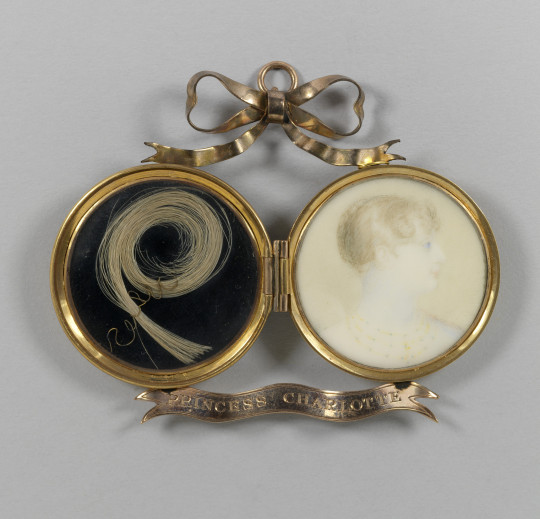
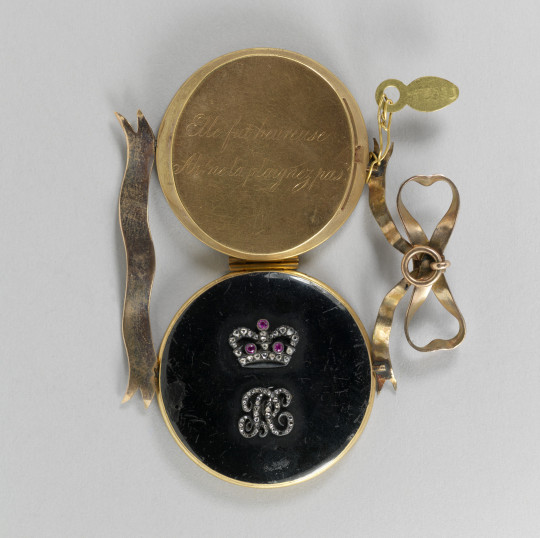
Princess Charlotte was the only child of George, prince of Wales, later George IV and Princess Caroline of Brunswick. After her parents separated, she joined the Prince of Wales’ household at Carlton House and then was taken to live at the Lower Lodge, Windsor Castle, from 1805 onwards. Her relationship with her father was distant, particularly when she broke off her engagement to William, the Hereditary Duke of Orange, in 1813. In May 1816, she married Prince Leopold of Saxe-Coburg-Saalfeld, later King of the Belgians, but died soon after the birth of a stillborn son in 1817. She had become a very popular figure and was deeply mourned both by her husband and the general public.
The miniature has been worked up from a pencil drawing by George Sanders made during sittings he had in 1813 for a portrait the princess wanted to give her father for a birthday present.
The miniature is set in a hinged case with a lock of Princess Charlotte’s hair. The front of the locket is black enamel with a coronet of rubies and diamonds and her monogram PC. The plain gold back is engraved: Elle fut heureuse / Ah! Ne la plaignez pas (She was happy. Ah! do not weep for her).
Source
#princess charlotte#princess charlotte augusta#princess charlotte of wales#regency era#miniature#the royal collection#george iv#long live the queue
66 notes
·
View notes
Text
The Christmas tree: From pagan origins and Christian symbolism to secular status
A Christmas tree adorned with ornaments and lights is a centrepiece of the festive season. But have you ever wondered where the tradition comes from?
Evergreen trees and plants have been used to celebrate winter festivals for thousands of years, long before the advent of Christianity.
Pagans in Europe used branches of evergreen fir trees to decorate their homes and brighten their spirits during the winter solstice.
Early Romans used evergreens to decorate their temples at the festival of Saturnalia, while ancient Egyptians used green palm rushes as part of their worship of the god Ra.
"The idea of bringing the evergreen into the house represents fertility and new life in the darkness of winter, which was much more of the pagan themes," Dr Dominique Wilson from the University of Sydney said.
"That's also where the ideas of the holly and the ivy and the mistletoe come from because they're the few flowering plants at winter so therefore they hold special significance.
"So the idea of bringing evergreens into the house started there and eventually that evolved into the Christmas tree."
From pagan customs to Christianity
There are several theories and legends as to how the evergreen fir tree went on to become a symbol of Christianity.
One is credited to the English Benedictine monk Boniface, famous for his missionary work in Germany during the eighth century.
"The common story goes that [Boniface] encountered some native Germans performing some sacrifices in front of a mighty oak tree — oak trees being sacred to the god Thor," Dr Wilson said.
"Boniface seized his axe and felled the tree in order to stop the pagans worshiping a false idol and the pagans were waiting for him to be struck down by lightning, but it didn't happen.
"So at this stage he took the opportunity to convert them."
Then legend has it that a fir tree grew out of the fallen oak.
"That became a symbol of Christ — being triangular in shape it represents the trinity — and from there came the idea that the tree should be a symbol of Christ and new life," Dr Wilson said.
"That's one of the main origins of the Christmas tree and bringing it into the house."
Modern Christmas trees a German tradition
Modern Christmas trees emerged in western Germany during the 16th century as Christians brought trees into their homes and decorated them with gingerbread, nuts and apples.
"It's the 17th century that we really get the decorating happening, and we get a movement into the festivals and the big royal courts having these trees with the gold leaf on them, having paper decorations with candles," Dr Wilson said.
The custom became popular among nobility and spread to royal courts across Europe in the early 19th century.
As Germans emigrated to other parts of the world the tradition also spread.
But in places like the United States, having a Christmas tree was often viewed as a foreign pagan custom until the mid-19th century.
Queen Victoria, Prince Albert popularise Christmas trees
While the Christmas tree originated in Germany, it was Britain's Queen Victoria and Prince Albert who popularised it in the 1840s and 1850s.
Victoria's mother, Princess Victoria of Saxe-Coburg-Saalfeld, was German so she grew up having a decorated tree at Christmas time.
But the idea of decorating a whole tree was not common among Brits until a drawing of the royal family celebrating around a decorated Christmas tree in Windsor Castle was published by the Illustrated London News in 1848.
This illustration of Queen Victoria and Prince Albert with their children around a Christmas tree featured in the Illustrated London News in 1848.
Victoria and Albert were popular royals and soon every British home had a tree decked out with decorations, candles and sweets.
The same image was published two years later in the United States in Godey's Lady's Book — though Victoria's tiara and Albert's moustache were removed to make the image more American.
It was the first widely circulated picture of a decorated evergreen Christmas tree in the US and soon the Christmas tree was in vogue.
Christmas trees today
Today, Christmas trees come in all different shapes and sizes from traditional fir to artificial.
The tradition of decorating a tree is embraced by millions of people worldwide of different faiths and cultures.
While it is still a symbol of Christianity to some, to others it is simply part of December celebrations.
"Here in Australia we've embraced the European aspect of Christmas," Dr Wilson said.
"We eat the fish and the prawns, et cetera, but I think we are relatively traditional.
"The fact that so many of us still do the turkey and the ham, placing the gifts under the tree — that's definitely something that links back to our European roots."

#christmas#christianity#gif#evergreen#Saturnalia#paganism#orginstory#christmas tree#history#natural history#Ra#christ
124 notes
·
View notes
Text



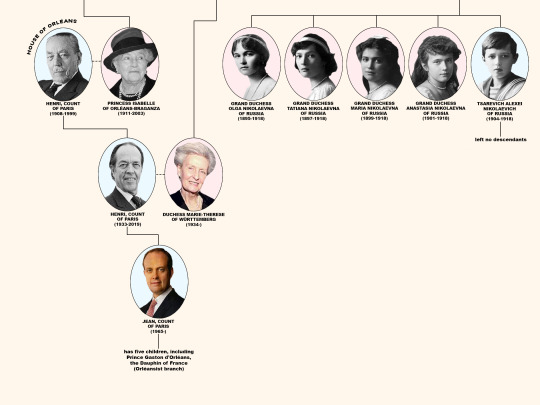
How the last Russian Dynasty were related to European Monarchies (current and former):
The House of Oléans (current legitimist of Royal Dynasty of France-Oléanists) and the House of Holstein-Gottorp-Romanov (Imperial Dynasty of Russia) were related, their ancestors Francis, Duke of Saxe-Coburg-Saalfeld and Frederick II Eugene, Duke of Württemberg.
11 notes
·
View notes
Text
Are the British Royal Family German?
So, it’s quite often said that the British Royal Family aren't British at all and are in fact German. This comment is usually thrown around by anti-monarchists and in a derogatory way. But, is it true?
Well, this question is often answered as ‘yes’ because of the fact that King George V changed the Royal family’s last name in 1917 from The House of Saxe Coburg and Gotha to the House of Windsor. Why did he do this? Well during WW1 there was understandably a lot of anti-German sentiment going around and the Royal family not only had a German last name and held German titles but King George V was a first cousin to the German Kaiser Wilhelm II. When searching for a new name for the Royal family suggestions such as Plantagenet, Tudor and even England were thrown into the mix, but King George eventually settled on The House of Windsor, named after Windsor Castle and much more English sounding then their previous last name. On June 19th 1917 King George also ordered that the British Royal family dispense with the use of all German titles and surnames.
But the story of the Royal family being German predates WW1 and we have to go back to the 18th century. In 1714 Queen Anne died and despite having had 17 pregnancies her eldest surviving child only lived to be 11 years old and predeceased his mother. So, when Anne died, we were in need of a new and most importantly a Protestant monarch. Anne’s father, the Catholic King James II had fled England in the “Glorious Revolution” of 1688 and his nephew, the Protestant William, Prince of Orange and his wife Princess Mary (James’ daughter) were invited to take up the throne as joint monarchs and became King William II and Queen Mary II. William and Mary had no children and so when they both died the throne passed to Anne.
There were plenty of heirs that could have followed Anne onto the throne but the problem was they were mostly Catholics. The 1701 Act of Settlement settled the succession onto the nearest Protestant heir the Electress Sophia of Hanover who was a granddaughter of King James I. The Act stated that the monarch could no longer be a Roman Catholic or married to a Roman Catholic, as a result the Act completely bypassed Anne’s brother the Catholic Prince James Francis Edward, known to history as The Old Pretender. The Act later extended to Scotland after the Act of Union in 1707 that led to The United Kingdom of Great Britain.
Sophia, unfortunately died just two months before Anne did so she never got to be Queen. The succession instead went to her eldest son Georg Ludwig, the Prince Elector of Hanover. Georg became King George I of Great Britain and he couldn’t speak a word of English. George made no secret of the fact his heart lay with Hanover and he would spend a great deal of his time going back there and would be buried there.
George II had the fact that he could speak England going for him, but it wouldn’t be until King George III that we would get a King that had been born in Britain and could speak perfect English. George was the grandson of George II; his father had been Frederick Prince of Wales who had been left in Hanover as the family's representative when George I became King. Frederick had only been a child when his grandfather and his parents left for England, and he was an adult by the time he actually came to England as Prince of Wales. Long story cut short Frederick and his parents detested each other.
Every monarch since King George III have been born and raised in Britain, that's King George IV, King William IV, Queen Victoria. Edward VII, George V, George VI and Queen Elizabeth II.
Queen Victoria was the daughter of Prince Edward duke of Kent (son of George III) and the German Princess Victoria of Saxe Coburg – Saalfeld. Subsequently, Queen Victoria’s first language was German, but she was also taught English and French.
Victoria married her German first cousin Prince Albert of Saxe Coburg and Gotha and she was the last monarch of The House of Hanover. Victoria and Albert’s eldest son became King Edward VII and the first monarch of the House of Saxe Coburg and Gotha. They remained the House of Saxe Coburg and Gotha until we come full circle to where I began with George V changing the family name to the House of Windsor.
Now, even though all the monarchs from George III onwards have been born and raised in Britain they do have an awful lot of German blood. Most of the monarchs we have had since George I have married a German princess, save for Edward VII who married a Danish Princess, King Edward VIII who abdicated to marry an American, King George VI who married an English/Scot and our current Queen who married a Greek/Danish Prince. This all goes back to when a Prince or Princess had to marry the ‘right sort’ of person. Usually another Prince or Princess, and thanks to Queen Victoria having 9 children and marrying them off to other royal houses they all became related in some kind of way. That’s how The Queen and Prince Philip were cousins, albeit very distant ones. You could be married to a distant cousin and have no idea about it.
The Royals are no longer required to marry another Prince or Princess from another country. That would be a lot harder now anyway since many monarchies have fallen since this was the norm. Royals have a lot more freedom when it comes to who they marry now, Diana, Fergie, Kate Middleton, Anthony Armstrong Jones, Mike Tindal and Meghan Markle are proof of this. Kings and Queens very rarely used to marry an English woman, there was no diplomatic advantage to it. King Henry VIII was the exception to this, but he had a few issues getting foreign princesses to actually even entertain the idea of marrying him after his history with women.
So yes, the Royal Family have an awful lot of German blood, but does that make them German? None of them since George II have been born in Germany and none of them have been raised there. If you go purely off of ancestry then we haven't had an English monarch since the 1066 Norman Conquest. We have had The Normans and Plantagenets who were French. We have had The Tudors who were descended from a Welshman, The Stuarts who were Scottish and the Hanoverians, Saxe Coburg's and Windsor's who have German and Danish ancestry along with the Welsh, Scottish and French going all the way back to 1066. You can trace The Queens lineage all the way back to William the Conqueror, but we don't call The Queen a Norman.
So, I would conclude that the Royal Family are not German but that they simply have a lot of German blood and ancestry. But the current Monarch, Prince Charles, Prince William and Prince George were all born in England to British parents (save Prince Philip who was of Greek and Danish decent).

#british royal family#queen elizabeth ll#prince charles#prince william#prince philip#prince george#prince harry#duke of cambridge#duke of sussex#prince of wales#royalty#house of windsor
5 notes
·
View notes
Text
AUGUST
Prince of Saxe-Coburg and Gotha
(born 1818 - died 1881)
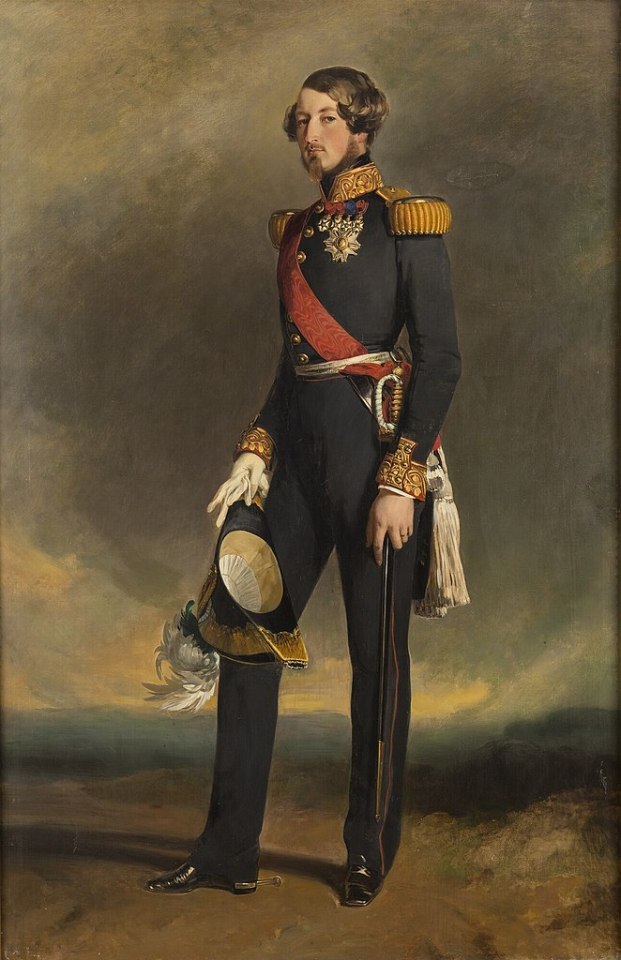
pictured above is a portrait of the Prince of Saxe-Coburg and Gotha, by Franz Xaver Winterhalter from c. 1845
-------------------- ~ -------------------- ~ --------------------
SERIES - On this day July Edition: August died on 26 July 1881.
-------------------- ~ -------------------- ~ --------------------
AUGUST VIKTOR LUDWIG was born in 1818, in Vienna. His parents were Prince Ferdinand of Saxe-Coburg-Saalfeld and Princess Mária Antónia Koháry of Csábrág and Szitnya, of Hungarian nobility.
He was born into the Saxe-Coburg-Saalfeld line of the Ernestine branch of the HOUSE OF WETTIN, a dynasty that ruled Saxon territories in the Holy Roman Empire since the 11th century. And thus was from birth a PRINCE OF SAXE-COBURG-SAALFELD.
In 1826 his maternal grandfather Ferenc József, Prince Koháry of Csábrág and Szitnya died and his mother inherited the rich Koháry estate in Hungary.
That same year his uncle Ernst III, Duke of Saxe-Coburg-Saalfeld concluded an agreement with other members of the Ernestine branch of the House of Wettin over the Duchy of Gotha, whose ruler had died the year before. By this agreement Saalfeld was exchanged for Gotha and thus his uncle became Ernst I, Duke of Saxe-Coburg and Gotha.
This event created a new cadet branch of the House of Wettin, the HOUSE OF SAXE-COBURG AND GOTHA, of which he was technically a member. However as his immediate family was in control of the Koháry estate in Hungary they became known as the HOUSE OF SAXE-COBURG AND GOTHA-KOHÁRY, although he was officially a PRINCE OF SAXE-COBURG AND GOTHA.
In 1843 he married MARIE CLÉMENTINE LÉOPOLDINE CAROLINE CLOTILDE, a Princess of Orléans, the youngster daughter of Louis-Philippe I, King of the French and Princess Maria Amalia of Naples and Sicily. With her he had five children (check the list below).
Although he was not the eldest son he inherited the Koháry estate when his mother died in 1862, because his brother Ferdinand II, King Father of Portugal had renounced his rights to marry Maria II, Queen of Portugal in 1836. And through this inheritance he became a wealthy man, owning properties in Austria and Hungary.
Aged 63, the Prince of Saxe-Coburg and Gotha died on 26 July 1881, at one of his Austrian residences Schloss Ebenthal in Carinthia. He was buried at St. Agustin, a Roman Catholic Church in Coburg, that he had built to serve as his family's mausoleum.
-------------------- ~ -------------------- ~ --------------------
AUGUST and his wife CLÉMENTINE had five children...
Prince Philipp of Saxe-Coburg and Gotha - husband of Princess Louise of Belgium;
Prince Ludwig August of Saxe-Coburg and Gotha - husband of Princess Leopoldina of Brazil;
Princess Clotilde of Saxe-Coburg and Gotha - wife of József Károly, (titular) Palatine of Hungary;
Princess Amalie of Saxe-Coburg and Gotha - wife of Duke Maximilian Emanuel in Bavaria; and
Ferdinand I, Tsar of Bulgaria - husband first of Princess Maria Luisa of Bourbon-Parma, second of Princess Eleonore Reuss of Köstritz and third of Alžbeta Brezáková.
-------------------- ~ -------------------- ~ --------------------
In History, specially Royal History, everything is somehow connected!
And through his relatives the Prince was well connected to many Royal Families around the world, such as:
Belgium, as a nephew of King Leopold I;
Portugal, as a younger brother of King Fernando II;
United Kingdom, as a first cousin of Queen Victoria;
France, as a son-in-law of King Louis-Philippe I;
Bulgaria, as the father of Tsar Ferdinand I; and
Brazil, as the father-in-law of Princess Leopoldina.
#august of saxe coburg and gotha#prince august of saxe coburg and gotha#prince of saxe coburg and gotha#saxe coburg saalfeld#house of saxe coburg saalfeld#saxe coburg and gotha#house of saxe coburg and gotha#saxe coburg and gotha kohary#house of saxe coburg and gotha kohary#german royals#german royalty#royals#royalty#monarchy#monarchies#royal history#german history#hungarian history#european history#world history#history#history lover#19th century#louis philippe#leopold i#queen victoria#fernando ii#history with laura
3 notes
·
View notes
Photo
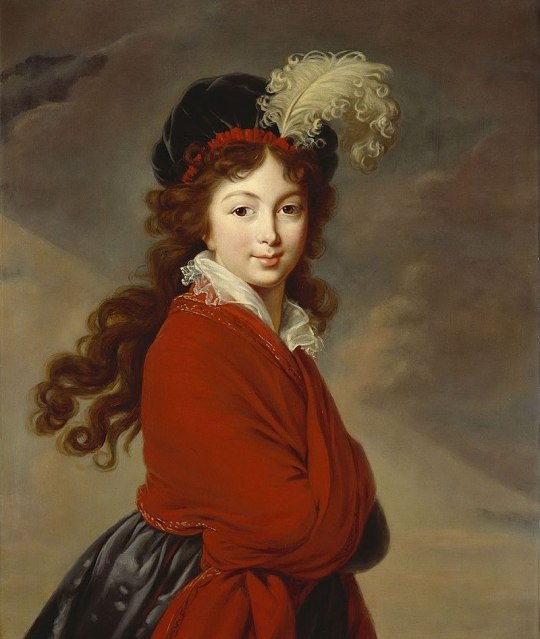
Princess Juliane Henriette Ulrike of Saxe-Coburg-Saalfeld (Coburg, 23 September 1781 – Elfenau, near Bern, Switzerland, 12 August 1860), also known as Grand Duchess Anna Feodorovna of Russia, was a German princess of the ducal house of Saxe-Coburg-Saalfeld who became the wife of Grand Duke Konstantin Pavlovich of Russia.
#Juliane of Saxe-Coburg-Saalfeld#House Saxe-Coburg-Saalfeld#XVIII century#XIX century#people#portrait#paintings#art#arte
22 notes
·
View notes